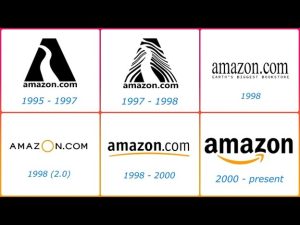The Amazon Logo History and Design Elements

Amazon, founded in 1994 by Jeff Bezos, has grown from a modest online bookstore into one of the world’s most influential e-commerce and technology giants. With its global presence spanning retail, cloud computing, artificial intelligence, and entertainment, Amazon has become a household name recognized across continents.
In the midst of this massive expansion, one element has remained consistently impactful, its logo. The design of a company’s logo is not just a visual mark; it serves as the cornerstone of its identity. It conveys values, builds trust, and fosters instant recognition among consumers. For Amazon, its logo plays a crucial role in reinforcing the brand’s promise of convenience, variety, and customer satisfaction.
A well-designed logo goes beyond aesthetics. It captures a brand’s mission, values, and personality, often within seconds of a viewer’s first impression. It fosters recognition, evokes emotional responses, and helps differentiate the brand from competitors. Consistency in logo usage across various platforms—websites, packaging, advertising, and mobile apps—strengthens the brand’s visibility and trustworthiness.
For global brands like Amazon, the logo is not just a mark, it’s a message. The iconic smile and arrow in the Amazon logo convey a sense of friendliness and reliability, reinforcing the company’s customer-centric philosophy. As Amazon expanded into diverse markets and services, the logo became a unifying element that helped maintain a consistent identity across all touchpoints.
The First Amazon Logo (1995–1997)

Amazon’s branding story begins in 1995, during the early days of the internet, when the concept of online shopping was still a novel idea. The company, founded by Jeff Bezos in a Seattle garage, launched its first website and introduced a logo that mirrored its initial identity: a simple, text-based design that reflected its ambition and clarity of purpose.
Visual Design and Typography
The first Amazon logo prominently featured the name “amazon.com” written in a black serif font, most likely Times New Roman or a similar typeface. Serif fonts, with their classic and formal appearance, conveyed a sense of authority, reliability, and trustworthiness, qualities essential for a startup trying to gain legitimacy in an untested digital marketplace.
Beneath the name was the bold tagline:
“Earth’s Biggest Bookstore”
This phrase did more than just explain what Amazon sold, it showcased the company’s audacious vision to offer the largest selection of books available anywhere, emphasizing its expansive reach and customer-centric approach. The inclusion of “.com” in the logo highlighted that Amazon was a pioneer of e-commerce at a time when few understood the true potential of the internet.
Symbolism and Strategic Messaging
The name “Amazon” was carefully chosen, not randomly. It referenced the Amazon River, the largest and one of the most resource-rich river systems in the world. This association was intentional; it symbolized the vast, seemingly endless selection Amazon aimed to offer its customers, even in its early days. The brand was positioning itself not just as another online bookseller but as a massive, unparalleled source of knowledge and literature.
Moreover, the logo had no icons, images, or flashy design elements. This minimalism wasn’t due to lack of creativity but rather strategic focus. In a time when internet speeds were slow and design tools were limited, a clean, quick-loading logo made perfect sense. It reflected the startup nature of the company, lean, efficient, and purpose-driven.
Branding in the Context of the Mid-90s
In 1995, user interface design and digital branding were still evolving. Companies were cautious about how they presented themselves online. Amazon’s early logo stood out for its directness and clarity. It was informative, professional, and confidence-inspiring for early web users who were hesitant about online transactions.
The tagline also played a crucial role in building customer trust. By declaring itself the “biggest,” Amazon set a bold tone for its brand, offering not just books but a new kind of shopping experience, convenient, comprehensive, and accessible from home.
Legacy of the Original Logo
Although basic by today’s standards, this logo marked the foundation of Amazon’s brand identity. It helped the company establish its name in the minds of early internet users. It was a practical and strategic design that effectively communicated what Amazon did, how it was different, and where it was headed.
This early version didn’t last long—only until 1997—but it played a critical role in the company’s journey. It gave Amazon a recognizable face and allowed the business to grow into broader markets before evolving into the more iconic and polished logos we see today.
The Evolution of the Amazon Logo

The Amazon logo has undergone several key transformations since the company’s launch in 1995, each reflecting its growing presence and shifting brand identity. The earliest logo (1995–1997) was a simple black serif typeface with the tagline “Earth’s Biggest Bookstore,” directly aligning with Amazon’s roots as an online bookseller. In 1997, a more structured and refined wordmark was introduced, still highlighting its bookstore origins but with improved visual balance.
The most significant redesign came in 2000, marking the birth of the now-iconic logo featuring a bold, lowercase “amazon” wordmark and a yellow arrow curving from “a” to “z.” This arrow symbolized the company’s vast product selection and doubled as a smile to reflect customer satisfaction. Since then, the logo has remained largely unchanged, becoming a symbol of reliability, convenience, and global reach—perfectly embodying Amazon’s brand as it continues to expand into new industries and markets.
First Major Redesign (1997–1998)

As Amazon began to gain traction in the e-commerce space, the company recognized the need for a stronger, more professional brand identity. This led to Amazon’s first major logo redesign in 1997, just two years after its initial launch. While the earlier logo had served its purpose during the startup phase, the evolving digital landscape and Amazon’s rapid growth demanded a logo that could better reflect its expanding vision.
Introduction of the Tagline: “Earth’s Biggest Bookstore”
Although this slogan had been used informally since the early days, the 1997 redesign formally incorporated the tagline “Earth’s Biggest Bookstore” into the logo design. By including the tagline directly beneath the company name, Amazon reinforced its commitment to being the most extensive and accessible online source for books anywhere in the world. The phrase was bold, memorable, and aspirational—perfectly aligning with Jeff Bezos’s global ambitions for the company.
This addition also served a dual purpose:
- It clarified Amazon’s core service for first-time visitors.
- It established a strong positioning statement that distinguished Amazon from traditional bookstores and smaller online competitors.
Use of a More Structured Typeface
The redesign introduced a more modern and geometrically structured sans-serif typeface, a significant departure from the original serif font. This shift reflected Amazon’s transition from a startup to a more established, tech-savvy organization. The cleaner lines and bolder letterforms added a sense of stability, professionalism, and digital fluency to the logo.
In this version, the word “amazon.com” was often displayed in uppercase or mixed-case, offering more visual weight and clarity. The structured type also made the logo easier to reproduce across different mediums—from websites to printed material and packaging.
Visual Identity and Branding Evolution
Although still relatively simple in design, this iteration of the logo began hinting at the design maturity that would come in later years. It removed any decorative elements or abstract symbols and relied instead on a confident wordmark and a powerful tagline. This made the brand identity easier to recognize, scalable, and more suitable for a growing catalog and user base.
The logo’s black-and-white color scheme remained unchanged during this phase, but the refinement in typography and layout marked a clear step forward. It gave the company a sleeker, more corporate look that aligned with its expanding reputation in the tech and retail industries.
Amazon Logo from 1998 to 2000

As Amazon rapidly evolved from an online bookstore into a broader e-commerce platform, its brand identity needed to reflect this transformation. In 1998, Amazon updated its logo once again, moving closer to the iconic version we know today. This iteration marked a transitional period—visually sharper, more modern, and more flexible across mediums, signifying Amazon’s growth beyond books and into new product categories.
Design Features and Typeface Evolution
The 1998–2000 logo retained the basic wordmark “amazon.com,” but this time in a clean, lowercase sans-serif font. The typeface used was more balanced and friendlier than in previous versions, helping to project Amazon’s growing emphasis on customer experience and ease of use.
Key features of this version included:
- All-lowercase letters, which made the logo more approachable and less corporate.
- Bolder, smoother font, offering better readability across devices and scales.
- Removal of the tagline “Earth’s Biggest Bookstore”—this was a pivotal move that reflected Amazon’s shift from a niche book retailer to a general e-commerce giant.
By dropping the book-focused slogan, Amazon was clearly signaling its expansion into other verticals like electronics, music, toys, and more.
Introduction of New Logo Concepts
During this period, Amazon began experimenting with visual elements that would eventually lead to the creation of its signature design. Several early concepts introduced subtle curves, underlines, or swooshes beneath the text—foreshadowing the famous “smile” logo that would debut in 2000.
These graphic elements added motion and warmth to the brand, suggesting a user-friendly and dynamic shopping experience. While these experiments were still minimal and evolving, they marked the brand’s move toward a more cohesive and emotional identity.
Why This Logo Mattered
The 1998 logo was important because it represented a strategic brand repositioning:
- Dropping the bookstore tagline was a bold move that allowed Amazon to compete as a general retailer.
- The more inviting font and layout helped the brand appeal to a wider audience beyond book buyers.
- It created a design language that was flexible, recognizable, and ready for international expansion.
This version acted as a crucial bridge between Amazon’s early startup roots and its emergence as a tech-driven global marketplace.
The 2000 Redesign & Now – Birth of the Iconic Smile
![]()
The year 2000 marked a pivotal moment in Amazon’s branding journey. As the company expanded far beyond books and into an all-encompassing online marketplace, it needed a visual identity that could match its bold ambition and resonate universally. This led to the creation of the now-iconic Amazon logo—a design so simple yet powerful, it has remained virtually unchanged for over two decades.
Introduction of the Current Logo
In 2000, Amazon unveiled a refined logo that introduced a visual element for the first time: a curved yellow arrow stretching from the letter “a” to the letter “z” beneath the wordmark “amazon.com.” This new design was more than just aesthetically pleasing—it became a meaningful symbol of Amazon’s mission and customer promise.
The wordmark itself remained in lowercase but adopted a sleek, bold sans-serif font (customized from Officina Sans), giving it a clean, confident, and tech-forward look.
Design Team and Rationale Behind the Update
The logo redesign was led by Turner Duckworth, a globally renowned branding and design agency. The rationale was simple yet profound: Amazon needed a timeless, global, and emotionally resonant identity. The arrow and smile weren’t just graphic flourishes—they were strategic elements designed to reflect Amazon’s evolving role in people’s daily lives.
Jeff Bezos himself was reportedly involved in guiding the vision for the redesign, emphasizing two key themes:
- Comprehensiveness: Amazon sells everything “from A to Z.”
- Delight: The company’s goal is to make every customer experience positive and satisfying.
Key Elements of the 2000 Logo
The Yellow Arrow / Smile
The most recognizable part of the logo is the yellow curved arrow that starts under the letter “a” and ends under the “z.” This design serves a dual purpose:
- Literal connection from A to Z: Representing the vast range of products available on Amazon—books, electronics, clothing, household items, and beyond.
- Stylized smile: The upward curve of the arrow resembles a smile, symbolizing customer happiness, satisfaction, and Amazon’s commitment to service.
Typography and Color
- Font: A custom variation of Officina Sans, known for its modern and approachable appearance.
- Color Scheme: The black wordmark conveys trust and authority, while the yellow-orange arrow adds warmth, optimism, and energy.
Symbolism and Brand Messaging
Every element of the 2000 logo was carefully considered to reflect Amazon’s evolving brand identity:
- A to Z communicates infinite variety, echoing Amazon’s promise of being a one-stop shop.
- The smile subtly reinforces Amazon’s focus on customer-centricity, fast delivery, and reliable service.
- The minimalism ensures the logo remains highly versatile and recognizable across platforms—from web and mobile apps to packaging and TV ads.
This was more than just a logo, it became a visual manifestation of Amazon’s core values: convenience, selection, reliability, and customer delight.
Symbolism and Hidden Meanings
The genius of the Amazon logo lies not in its complexity, but in its subtle layers of meaning. Introduced in 2000, the design is simple at first glance, just the word “amazon” with a yellow arrow underneath. But look a little closer, and you’ll find that this logo is packed with symbolism that perfectly reflects Amazon’s brand philosophy, customer promise, and business mission.
The Arrow from “A” to “Z”
One of the most recognized aspects of the logo is the curved yellow arrow that begins under the letter “a” and ends under the “z.” This isn’t a random flourish—it’s a powerful visual metaphor.
- Representation of Variety: The arrow from “A” to “Z” signifies that Amazon offers everything under the sun, from books to electronics, groceries, clothing, furniture, and even cloud computing services. It’s a visual shorthand for Amazon’s vast product range.
- Simplicity and Intelligence: The “A to Z” concept is immediately understandable and intuitive, making the message clear even to first-time users.
- Fulfillment Promise: It also implies completeness—you don’t need to look anywhere else because Amazon has it all, from the first letter of the alphabet to the last.
The Smile: Emotional Connection and Brand Personality
The arrow also cleverly doubles as a smile, giving the logo a warm, friendly feel.
- Positive Emotional Response: The upward curve suggests happiness, ease, and customer satisfaction—everything Amazon aims to deliver in its service.
- Customer-Centric Philosophy: This smile is not accidental; it visually reinforces Amazon’s mission to be “Earth’s most customer-centric company.”
- Human Touch in Tech: In a world dominated by technology, algorithms, and automation, the smile adds a human, emotional element to Amazon’s otherwise data-driven operations.
By integrating a smile into the core of its identity, Amazon subtly reminds its users that they’re at the heart of the business.
Reflection of Amazon’s Mission and Values
Every element of the Amazon logo is tied directly to its mission and long-term vision:
- Mission Statement: “To be Earth’s most customer-centric company, where people can find and discover anything they might want to buy online.”
- The arrow and smile together communicate:
- Ease of discovery (“A to Z”)
- Convenient access to anything
- Customer delight and trust
The logo thus becomes more than just branding—it’s a visual commitment to service, selection, and satisfaction.
Why It Works So Well
- Memorable: The dual symbolism makes it instantly recognizable and easy to recall.
- Timeless: It hasn’t needed to change in over two decades because it still resonates.
- Universal: Regardless of language or culture, people intuitively understand what the logo is trying to convey.
Psychological Impact and Branding Strategy
Amazon’s logo isn’t just a visual asset—it’s a strategic branding tool engineered to create an emotional connection, reinforce customer trust, and solidify brand recall. Behind its simplicity lies a smart combination of psychological cues and subtle storytelling that has helped Amazon become one of the most recognizable brands in the world.
The Emotional Appeal of the Smile
At the heart of the Amazon logo is the smile-shaped arrow, which subtly evokes feelings of happiness, satisfaction, and friendliness.
- Subconscious Positivity: Human brains are wired to respond positively to smiles. By embedding a smile into its logo, Amazon immediately triggers a positive emotional response—even before a customer interacts with the site.
- Trust and Comfort: The smile implies friendliness, warmth, and a sense of customer care, encouraging users to feel at ease while shopping online.
- Post-Purchase Delight: The upward curve reinforces the idea that Amazon wants customers to leave with a smile, positioning the brand as one that prioritizes end-to-end satisfaction.
This emotional resonance plays a major role in building long-term brand loyalty.
Subtlety of the A–Z Messaging for Brand Depth
The arrow from “A” to “Z” is a piece of subtle genius. While not everyone immediately notices this feature, its discovery often creates an “aha” moment that deepens the consumer’s appreciation of the brand.
- Cognitive Engagement: When customers realize the dual meaning of the arrow (a smile and a product range from A to Z), they feel a deeper, more personal connection with the brand. This type of cognitive reward helps in making the logo memorable.
- Subliminal Completeness: Even if a person doesn’t consciously recognize the A–Z implication, it still registers subconsciously as a symbol of comprehensiveness, reinforcing Amazon’s role as a one-stop shop.
This combination of obvious friendliness and hidden meaning gives the logo lasting depth and appeal.
Memorable and Universally Recognizable Design
The Amazon logo has achieved something rare in branding: instant global recognition. This is no accident—it’s a result of careful psychological design choices:
- Simple Typography: Clean, lowercase lettering makes the brand feel approachable and accessible to a global audience.
- Minimalist Design: The lack of clutter ensures the logo is instantly scalable, whether on a website header, mobile app, box packaging, or billboard.
- Cross-Cultural Relevance: The smile is a universal expression of happiness, requiring no translation. This makes the logo culturally neutral yet emotionally resonant across the world.
Combined, these factors ensure that the Amazon logo leaves a lasting impression wherever it appears.
Strategic Branding Takeaways
Amazon’s logo isn’t just a pretty mark—it’s a psychologically crafted symbol that supports the company’s branding strategy on multiple levels:
- Creates emotional connection through subtle visual cues
- Reinforces brand promise (variety and satisfaction) without words
- Increases recall and recognition, making Amazon top-of-mind for shoppers
- Supports trust and reliability, which are crucial in e-commerce
This kind of design is not accidental—it reflects a deep understanding of consumer behavior and perception, and it plays a critical role in Amazon’s dominance.
Frequently Asked Questions (FAQs)
Q1: When was the first Amazon logo created?
A: The first Amazon logo was introduced in 1995, when the company launched as an online bookstore. It featured a large, stylized “A” with a river running through it, representing the Amazon River.
Q2: What does the arrow in the Amazon logo represent?
A: The iconic arrow in the current Amazon logo starts at the letter “a” and points to “z,” symbolizing that Amazon offers everything from A to Z. It also resembles a smile, representing customer satisfaction.
Q3: When was the current Amazon logo introduced?
A: The current Amazon logo was introduced in the year 2000. It features a clean, bold “amazon” wordmark with the signature yellow arrow underneath.
Q4: Who designed the Amazon logo?
A: The current Amazon logo was designed by Turner Duckworth, a London and San Francisco-based branding agency. The firm helped refine the logo to convey trust, simplicity, and friendliness.
Q5: Has Amazon changed its logo over time?
A: Yes, Amazon has updated its logo multiple times since its inception. It evolved from a complex graphic to a minimalist, modern wordmark with an arrow that has become one of the most recognizable logos worldwide.
Conclusion
The evolution of Amazon’s logo mirrors the company’s transformation from a humble online bookstore into a global tech and retail giant. Each design phase—from the basic serif wordmark to the iconic smile introduced in 2000—has aligned with Amazon’s expanding vision. The current logo’s simplicity and clever use of the arrow from “A” to “Z” subtly convey the brand’s promise of variety, accessibility, and customer satisfaction.
More than just a visual mark, the Amazon logo embodies the company’s mission to be Earth’s most customer-centric business. The smile evokes trust and positivity, while the minimalist design ensures global recognition and emotional resonance. It’s a powerful example of how thoughtful, meaningful design can become a lasting symbol of a brand’s values and ambitions.